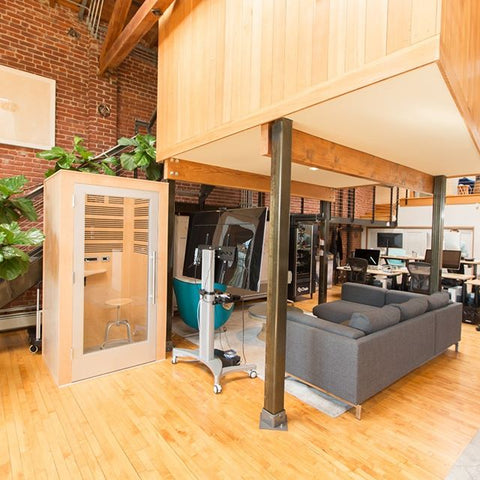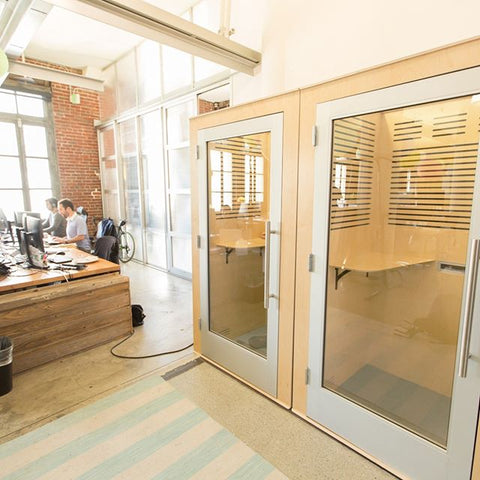It's not just the nature of work that has changed; in today's global, increasingly digital-first economy, the needs of workers have also shifted.
Productivity is no longer about punching a time card or clocking in and out. It's about how powerfully, efficiently and effectively workers can use their 9 to 5 hours. In other words, working smarter, not necessarily harder.
Part of working smarter means working in an environment that supports the format of the work being done and the stage of the project the work is at.

image source: http://www.entrawood.co.za
The rise in co-working spaces doesn't only parallel the rise in remote workers and the changing nature of working hours.
It also tells us that there is a preference for larger companies to rely on smaller, leaner teams, and groups who can demonstrate a deep expertise, working on a project-to-project basis.
Running a tight but steadily moving ship like this requires an office that will be as responsive as the principles these cohorts are built on.
A productive workspace is not only a flexible one or a balanced one, with ample room for various sizes and functions, it's also an "agile" one. It's a workplace design that mimics the inquiry, creativity, testing, development, and design stages that are at the core of the work itself.

So how do you apply these innovative software development principles when it comes to office design? Simple: by creating agile workspaces.
The Office Feel of Agile Workspaces
When it comes to creative ideas and design solutions that deserve to see the light of day, there can be a tendency to get bogged down in the details of a project. Here's where the team can dissolve into a cacophony of noises that are not communicating effectively — nor are they working effectively.
Agile development says it is progress, not perfection, that matters most. When the simplest version is ready to go live, then that's what must happen. Meanwhile, the team can continue updating and working proactively behind the scenes.
Agile workplaces, like the agile development process, show a bias towards proximity, flexibility, and scale. It can be customized and optimized according to a team's needs.
Let's say that "agile working" principles are in place for a team. What does their office design look like? There are five essentials to the "agile" working environment.
Open Plan Areas
The backbone of every agile working space is an open concept floor plan. Despite the noted downsides of open plan offices, there are ways to mitigate the negatives and maintain the positives.
These types of workspaces can help with informal communication, organic interaction, and engagement among employees, and are perfect for computer-based work.
This design is space-conscious and allows people to work on their own tasks while easily interfacing with their colleagues across from them. There is a sense of shared responsibility, since the large community table is "home" for everyone.
Agile Offices Need Resources
Let's talk about resources next because it's one of those "backbone" aspects. The open area floor plan needs to have one allocated space dedicated to the storage of resources.

These are crucial not only for files related to project and team needs but the functions that a team will require, including copiers, printers, recycling stations, and stationary storage.
Obviously, to reduce physical clutter and provide a mental separation, the "resource" zone should be walled off using a partition and regularly cleaned of strewn paper and debris.
Agile Workspaces Need Breakout Areas & Agile Office Furniture
These next three zones are the "meat and potatoes" of an agile workspace. They're built for functionality, flexibility, and collaboration simultaneously.
Remember when you were in grade school science class and got to switch from experiment to experiment across the room?
Breakout areas are like that fond memory. The exact same sense of exploration, discovery, and inquiry underlie the activities that occur here. So how are they designed?
There's the use of smaller group tables that can accommodate two to four people, with Wi-Fi points of access and charging stations throughout. Informal ad-hoc meetings and brainstorming sessions are at the heart of this space. So furniture with an open and welcoming use - like couches and coffee tables - are best here.
Creative collaboration and spontaneous problem-solving happen best when team members are relaxed. There is an element of "knowable unknown" here, insofar as creating a relaxed environment that will nurture innovative connections.
Instead of telling people how to behave at desks, there is a sense of community that underpins breakout zones. It's both a place you can go and a mindset you can take on.
Office Quiet Zones
These are areas where privacy, silence, analytical thinking, focus, and concentration are desired experiences.
Keeping in line with this theme are enclosed spaces like "phone pods" or partially covered "phone booths" specially designed to eliminate distraction and noises.
Quiet zones directly succeed breakout areas. Even though various team members can be occupying these spaces simultaneously, once a team has left they can then enter a meditative and reflective phase.
Here deeper insights can start to coalesce and produce meaningful solutions.

This is why it's so important to have a physically allocated space that doesn't produce isolation but rather encourages disconnecting with others and connecting with the work instead.
Agile Workspace Touchdown Areas
Agile development is both cyclical and simultaneous. While teams will migrate from breakout to quiet zones and back again, touchdown areas are just as important.
Note that all "areas" in the agile workspace are centered around informal, creative interactions that feature collaboration across functions (i.e. business with development and design).
Though there is always professionalism, the idea is that the work is exciting, engaging, and deep enough for workers to bring their passion and expertise in a free-spirited way.
Touchdown areas are for when teams are getting to the heart of the project and require a way to communicate, face-to-face, in an ongoing manner that is fast paced & easily accessible.
These can be long tables with one side pressed against a wall on the outer perimeter of a room, surrounded by chairs.
Their functions can include providing an informal, short-term workspace for remote, contract, or less frequent workers on the team.
Like breakout zones, they should be Wi-Fi accessible and feature charging stations.
Agile Workspace Benefits
Why do agile workspaces "work"? While any office design can include the latest trendy and modular furniture, the beauty of agile is the ethic that underlies it.
This ethic aligns three specific things: where team members are working, how they're working and what they're working on.
Individualism v.s. Collaboration
Overall, agile spaces provide a healthy balance between the individual's need for quiet, reflective, and focused work vs. a larger team's function of collaboration to work through complex problems.
Movability is the key to making these workspaces flexible. That is to say, each of the five areas, while having their own distinct features, should be easily accessible.

Optimized Teams
Another beauty of agile workspaces is that they account for a diverse hierarchy of teams. It is generous and flexible enough to accommodate large, multi-person teams in a way where everyone is sitting across from each other, relaxed and ready to brainstorm.
But it also just as easily shows a bias towards two or three people teams who may not visit the workplace until it's their "turn" on stage, so to speak.
By adding and removing chairs and incorporating a blend of partitioned as well as open working areas, teams can optimize the way they work.
For example, if they need to be together for references and questions but each is working on their own tasks, the touchdown area is perfect.
If they'd like to work out some solutions through running a sprint, a meeting room or even a breakout area is a great solution.
Integrating Generations From Boomers to Millennials
What else makes agile workspaces so well-suited for creative design and development agencies?
Besides keeping the functionality of teams at the forefront, it also privileges communication as the active ingredient to excellent working design that is both technically strong and customer-centric.
Communication is at the heart of the way workers respond externally to customers but, more importantly, how they work together as a team.
Agile workspaces give this more than lip service by incorporating communication as a desirable end in itself. Because nowhere is there more strife in communication in the workplace than across generations.
It's not only multi-function teams we're contending with — it's often also multi-generational teams.
The truth is that just as each individual has their own strengths and perspectives, so does each generation have its own tendency towards what constitutes valuable communication.
According to research by Dr. Mary Donohue on generational communication in the workplace, "Boomers prefer an auditory style, Gen X prefer a visual style and Millennials prefer a kinesthetic style of communication."
The way these generations work, what kind of behavior they value versus what kind they find "unprofessional" and what perspective they're likely to bring to the team all are different.
Focused Areas of Work
Let's take the example of multi-generational teams again. Imagine a scenario in which a millennial team member is having a conversation on the phone of a slightly personal nature in a breakout zone.
They see nothing "wrong" with it.
Meanwhile, a boomer might be absolutely prickled by the fact that bits and pieces of this conversation are floating down the community table and interrupting their work.
They might consider it rude. And this might come up, later on, in more emotionally charged ways, causing a conflict between co-workers over a simple matter of values.
Neither is wrong. What they need in this case would be separate working environments. In this example, the boomer might choose to retreat to the quiet of a Zenbooth one-person office pod or take their meeting to a two-person executive booth.
Having the ability to transition between various areas of work with a clear focus is precisely what avoids miscommunication.

DIY — What Every Agile Workplace Design Needs
Take a look at your open concept floor plan. Really scrutinize it. Are you starting to see its potential in an entirely new light? Perhaps even an agile light?
Now that you know the principles, the structure and the benefits, it's time to get started on your own agile design.
Harnessing "User" Feedback
When deciding on trending office furniture pieces, consult with your team. Roll out changes slowly so that members are not completely overwhelmed.
Remember that even if it's positive, change in the workplace is often viewed as threatening.
So take the time to incorporate "user feedback" from teams at the very beginning and then, continuously, as you make progressive additions.
Making Movable Parts
Don't like this chair here? Need the height adjusted? Need a quiet work zone that functions as a meeting room and a single-person sanctuary.
Consider using movable, modular furniture that matches the heights of various workspaces.
Use portable, standalone office booths that cut out noise for the worker looking to do some deep, focused tasks.
Organic Engagement
Create communal areas that are welcoming and comfortable in order to spark conversations that can lead to organic engagement with a project's design problem.
This can mean breakout areas are right at the center with easy access to an open-space cafeteria or eating area.
Noise Reduction
Remember that the corollary to the breakout area is the quiet zone. This is a natural part of the creative and design process.
Some offices choose to have a designated quiet space but teams will find that noise inevitably carries too far.
Despite best efforts, this is the "con" of an open concept workspace that must be addressed.
And it can be, through the use of enclosed, compact office booths. Often, these designs promote focused thinking and concentrated work by providing a nice blend between a glass door and a cozy, personalized office.
Team members can access the outside world at a glance and go back to their deep work the next moment. Virtually soundproof wall technology cuts out rather than "reduces" ambient noise, and smart, motion-sensor ventilation systems make these intimate spaces fresh rather than stuffy.

Strategic Placement
In a few weeks, you might change the entire physical layout of the workspace you're in. That's absolutely fine. But remember that these five areas are key, too.
Partitions between the resource and breakout areas don't need to be temporary. And at this stage they shouldn't be. That's why it's recommended to keep furniture as movable and extensible as possible - so that it can be transitioned across areas to see what works best.
Testing on the go, as various projects launch, is one of the key components of agile development and agile workspace design.
There is something about the routine and sense of professionalism that comes form having a co-working space tailored to company's needs. Well-designed, responsive office spaces have the ability to completely shift a team's perspectives on the projects they take on, and ultimately how positively their work impacts the world around them.
But first, the world around them should be designed to create a positive impact on them. For help getting started on your agile workspace, get in touch with Zenbooth here.